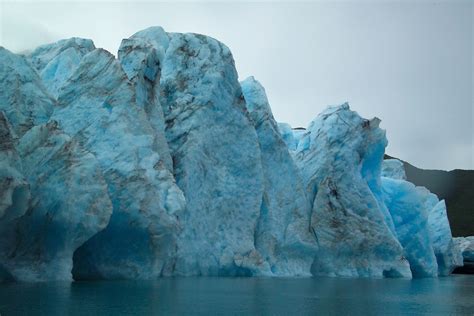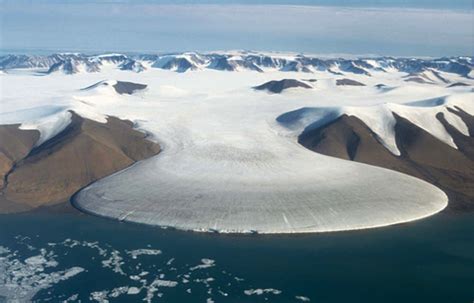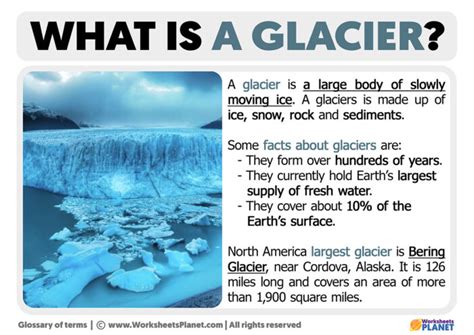Glaciation, a complex and multifaceted geological process, has played a pivotal role in shaping the Earth's landscape over millions of years. The term "glaciation" refers to the formation, growth, and movement of glaciers, which are large, perennial masses of ice that form on land by the accumulation and compaction of snow over time. This process has been instrumental in sculpting the Earth's surface, creating unique landforms, and influencing global climate patterns.
Glaciers are formed when snow accumulates in high-latitude or high-altitude regions, where the temperature and precipitation conditions are favorable for snow to persist year-round. As the snow accumulates, it compresses into ice, and the weight of the overlying ice causes the lower layers to deform and flow. This flow can occur through a combination of processes, including sliding, deformation, and calving, which ultimately leads to the glacier's advance or retreat. The movement of glaciers is influenced by various factors, including temperature, precipitation, and topography, and can have significant impacts on the surrounding environment.
Key Points
- Glaciation is the process of glacier formation, growth, and movement, which shapes the Earth's landscape and influences global climate patterns.
- Glaciers are formed through the accumulation and compaction of snow, and their movement is influenced by factors such as temperature, precipitation, and topography.
- Glaciation has played a crucial role in shaping the Earth's surface, creating unique landforms, and influencing global climate patterns over millions of years.
- The process of glaciation is closely tied to changes in global climate patterns, and understanding glaciation is essential for predicting future climate change.
- Glaciers store approximately 75% of the world's freshwater, and changes in glacier mass balance can have significant impacts on sea levels and global water resources.
Types of Glaciers

There are several types of glaciers, each with distinct characteristics and behaviors. Continental glaciers, also known as ice sheets, are large, continuous masses of ice that cover vast areas of land. They can be thousands of feet thick and are formed when snow accumulates over a long period. Alpine glaciers, on the other hand, are smaller and are found in mountainous regions. They are formed when snow accumulates in high-altitude valleys and are often characterized by their steep, rugged terrain.
Other types of glaciers include valley glaciers, which are long, narrow glaciers that flow through valleys, and piedmont glaciers, which are formed when valley glaciers merge and spread out into a broad, flat area. Glacierets, which are small, isolated glaciers, and icefields, which are large, flat areas of ice, are also important types of glaciers. Each type of glacier has its unique characteristics, and understanding these differences is essential for understanding the complex process of glaciation.
Glacial Landforms
Glaciers are responsible for creating a wide range of unique landforms, including glacial valleys, U-shaped valleys, and glacial lakes. Glacial valleys are formed when a glacier flows through a valley, carving out the rock and creating a U-shaped profile. Glacial lakes are formed when a glacier melts and leaves behind a depression that fills with water. Other glacial landforms include drumlins, which are elongated hills formed when a glacier pushes rocks and soil ahead of it, and eskers, which are long, sinuous ridges formed when sand and gravel are deposited by meltwater.
| Type of Glacial Landform | Description |
|---|---|
| Glacial Valley | Formed when a glacier flows through a valley, carving out the rock and creating a U-shaped profile. |
| Glacial Lake | Formed when a glacier melts and leaves behind a depression that fills with water. |
| Drumlin | Formed when a glacier pushes rocks and soil ahead of it, creating an elongated hill. |
| Esker | Formed when sand and gravel are deposited by meltwater, creating a long, sinuous ridge. |

Glaciation and Climate Change

Glaciation is closely tied to changes in global climate patterns. During periods of cooling, glaciers advance, and during periods of warming, they retreat. The current trend of global warming is causing many glaciers to retreat at an unprecedented rate, leading to concerns about sea-level rise and the impact on global water resources. Understanding the relationship between glaciation and climate change is essential for predicting future changes in the Earth’s climate and mitigating the impacts of climate change.
Glaciers store approximately 75% of the world's freshwater, and changes in glacier mass balance can have significant impacts on sea levels and global water resources. As glaciers melt, they contribute to sea-level rise, which can have devastating impacts on coastal communities and ecosystems. Additionally, changes in glacier mass balance can affect global water resources, leading to changes in river flow, water quality, and aquatic ecosystems.
Impacts of Glaciation
Glaciation has had a profound impact on the Earth’s surface, creating unique landforms and influencing global climate patterns. The movement of glaciers has carved out valleys, created lakes, and deposited rocks and soil in new locations. Glaciers have also played a crucial role in shaping the Earth’s surface, creating unique landforms such as drumlins, eskers, and glacial lakes.
In addition to their impact on the Earth's surface, glaciers have also had a significant impact on global climate patterns. During periods of glaciation, the Earth's climate is cooler, and the atmosphere is drier. This can lead to changes in precipitation patterns, sea levels, and the distribution of plants and animals. Understanding the impacts of glaciation is essential for predicting future changes in the Earth's climate and mitigating the impacts of climate change.
What is the difference between a glacier and an ice sheet?
+A glacier is a smaller, more localized mass of ice that flows through a valley or over a landscape, whereas an ice sheet is a large, continuous mass of ice that covers a vast area of land.
How do glaciers affect global climate patterns?
+Glaciers play a crucial role in regulating global climate patterns by reflecting sunlight, storing freshwater, and influencing ocean currents. Changes in glacier mass balance can have significant impacts on sea levels, global water resources, and the distribution of plants and animals.
What are the main types of glacial landforms?
+The main types of glacial landforms include glacial valleys, U-shaped valleys, glacial lakes, drumlins, and eskers. Each type of landform is formed through unique processes and is characterized by distinct features.
In conclusion, glaciation is a complex and multifaceted geological process that has played a pivotal role in shaping the Earth’s landscape over millions of years. Understanding the different types of glaciers, glacial landforms, and the impacts of glaciation is essential for grasping the complex process of glaciation and its role in influencing global climate patterns. By recognizing the unique characteristics of each type of glacier and glacial landform, researchers and scientists can better understand the role of glaciation in shaping the Earth’s surface and influencing global climate patterns.



